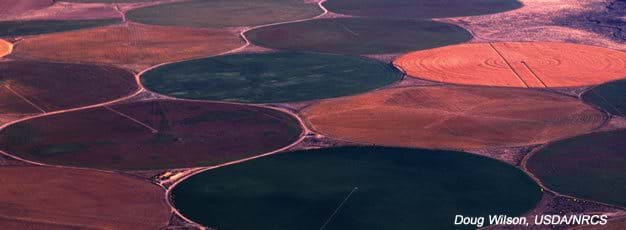Irrigated Acres Up, Water Application Rate Trending Down

Why do farmers irrigate? The benefits of irrigation include higher yields with increased drought protection, more cropping alternatives, reduced frost damage, higher quality products, and increased income stability. Nationally, irrigated corn yields are 30 percent greater than nonirrigated corn. Yield increases average over 60 percent for other field crops, yet the most valued contribution of irrigation is its use on vegetables, orchards, and horticultural crops.
In 2002, U.S. irrigated farmland occupied 55.3 million acres, down 1 million acres from 1997. In recent years, national irrigated area has stabilized at about 55 million acres as continuing growth in Eastern States has been offset by declines in Western States. Variations within the decades-long trend of increasing irrigated acres can largely be explained by year-to-year changes in four factors: farm program requirements, crop prices, water supplies in the West, and weather influences on the need for supplementary irrigation in humid areas. In general, there is an increasing reliance on irrigation in the humid East, with large concentrations of irrigation emerging in Florida, Georgia, and, especially, the Mississippi Delta, primarily Arkansas and Mississippi.
Changes in total water withdrawals for irrigation reflect per acre efficiency gains, shifts in crop locations, and changes in acres irrigated. Averaged over all States and crops, the average water application rate has declined by over 5 inches (about 20 percent) since 1969, to levels below 20 inches per acre in 2003. Producers have adopted more water-conserving practices and shifted production of some commodities to more humid and cooler areas, requiring less supplementary water. Irrigation application rates can vary from less than 6 inches per acre (sorghum in the North-Central States) to more than 4.5 feet per acre (orchards in the Mountain States). Per acre declines in application rates have partially offset the need for water to supply the increase in irrigated acreage. Over the 1969-2003 period, irrigated acreage increased by over 40 percent while total water applied increased by only 11 percent.
Irrigated agriculture is likely to remain important both as a demand on water resources and as a land cultivation practice. However, continued changes in the irrigation sector are anticipated in response to increasing water demands for urban and environmental uses, as well as evolving institutions governing farm programs and water allocations. Water withdrawals for agricultural production will likely continue to decline, with at least some portion shifted to satisfy alternative goals.
Agricultural Resources and Environmental Indicators, 2006 Edition, by Keith Wiebe and Noel Gollehon, USDA, Economic Research Service, July 2006


